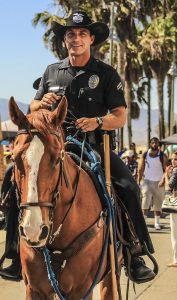As horsepeople, we frequently hear the term ringbone, but we may not understand what that term really means, or that it encompasses two different types of “ring bone”, not to mention the confounding “sidebone”. This blog is in response to a specific request from a client and I hope to shed a bit of light on this somewhat confusing topic.
Before delving into the topic of ringbone, we must first understand a bit about the anatomy of the distal limb. Just south of the fetlock there are the three main bones of the distal limb (the fourth being the navicular bone). From fetlock to floor, there’s the long pastern bone (P1) – labeled 1 in image, the short pastern bone (P2) labeled 2 in image, and the coffin bone (P3) labeled 4 in image. Between P1 and P2 lies the pastern joint, and between P2 and the coffin bone lies the coffin joint. Under the coffin bone, there is a collection of spongey tissue called the digital cushion which acts as a shock absorber for the limb. Additionally, on either side of the digital cushion lie the collateral cartilages with a similar function.
What is Ringbone?
Ringbone is a degenerative disease that can lead to varying levels of lameness and loss of performance. High ringbone is associated with the pastern joint while low ringbone is associated with the coffin joint. Mild to moderate ringbone of either location is diagnosed on radiographs while severe ringbone can often be visualized or palpated without x-ray vision.
The development of ringbone is usually associated with abnormal stresses being applied to the joint in question. These stresses can arise from a lifetime of work on hard surfaces (think carriage or police horses), horses with abnormal conformation causing them to load their distal limb in an asymmetric fashion, or horses with prior injuries to a soft tissue structure supporting the joint which leads to instability. In any situation, the body lays down additional bone to compensate for the atypical strain at the joint, and that bone in turn disrupts the normal, biomechanical function of the joint. Overall, ringbone is considered an osteoarthritic process.
Prognosis and Management of Ringbone
While there is no cure for ringbone, we can attempt to alleviate the pain associated with the condition. By reducing or eliminating the inflammation within the joint, we can also attempt to slow down the degenerative process. In mild cases, corrective shoeing and a joint support product like Adequan or Legend may be enough to alleviate the lameness. In moderate cases, intraarticular therapy using steroids, hyaluronic acid or IRAP may be required, while severe cases may have a poorer prognosis. Some severe cases may benefit from retirement and lifelong medical therapy while others may respond well to surgical fusion of the joint. Either way, severe ringbone carries a poor prognosis for future soundness.
What is Sidebone?
When the collateral cartilages of the foot are subjected to heavy ground forces, the cartilage ossifies and turns into bone. This is most common in horses working on hard surfaces or in shoeing styles where the quarters of the foot aren’t allowed to expand to displace additional forces. Sidebone is usually an incidental finding on radiographs and rarely causes lameness.
If you have any questions or concerns regarding ringbone and how it could potentially pertain to your horses, please don’t hesitate to reach out to Dr. Hartman or Dr. Baird for clarification or a lameness exam.




